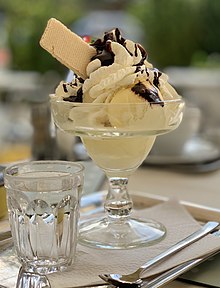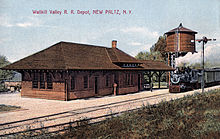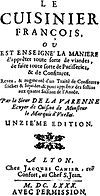F o o d
A portal dedicated to food and
foodways
Introduction


Food is any substance consumed by an organism for nutritional support. Food is usually of plant, animal, or fungal origin and contains essential nutrients such as carbohydrates, fats, proteins, vitamins, or minerals. The substance is ingested by an organism and assimilated by the organism's cells to provide energy, maintain life, or stimulate growth. Different species of animals have different feeding behaviours that satisfy the needs of their metabolisms and have evolved to fill a specific ecological niche within specific geographical contexts.
Omnivorous humans are highly adaptable and have adapted to obtain food in many different ecosystems. Humans generally use cooking to prepare food for consumption. The majority of the food energy required is supplied by the industrial food industry, which produces food through intensive agriculture and distributes it through complex food processing and food distribution systems. This system of conventional agriculture relies heavily on fossil fuels, which means that the food and agricultural systems are one of the major contributors to climate change, accounting for as much as 37% of total greenhouse gas emissions. ( Full article...)
Cooking, also known as cookery or professionally as the culinary arts, is the art, science and craft of using heat to make food more palatable, digestible, nutritious, or safe. Cooking techniques and ingredients vary widely, from grilling food over an open fire, to using electric stoves, to baking in various types of ovens, reflecting local conditions.
Preparing food with heat or fire is an activity unique to humans. Archeological evidence of cooking fires from at least 300,000 years ago exists, but some estimate that humans started cooking up to 2 million years ago.
The expansion of agriculture, commerce, trade, and transportation between civilizations in different regions offered cooks many new ingredients. New inventions and technologies, such as the invention of pottery for holding and boiling of water, expanded cooking techniques. Some modern cooks apply advanced scientific techniques to food preparation to further enhance the flavor of the dish served. ( Full article...)
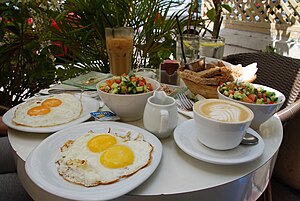
Israeli cuisine primarily comprises dishes brought from the Jewish diaspora, and has more recently been defined by the development of a notable fusion cuisine characterized by the mixing of Jewish cuisine and Arab cuisine. It also blends together the culinary traditions of the various diaspora groups, namely those of Middle Eastern Jews with roots in Southwest Asia and North Africa, Sephardi Jews from Iberia, and Ashkenazi Jews from Central and Eastern Europe.
The country's cuisine also incorporates food and drinks traditionally included in other Middle Eastern cuisines (e.g., Iranian cuisine from Persian Jews and Turkish cuisine from Turkish Jews) as well as in Mediterranean cuisines, such that spices like za'atar and foods such as falafel, hummus, msabbaha, shakshouka, and couscous are now widely popular in Israel. However, the identification of Arab dishes as Israeli has led to accusations of cultural appropriation against Israel by Palestinians and other Arabs. ( Full article...)
Selected article –
Ice cream is a frozen dessert typically made from milk or cream that has been flavoured with a sweetener, either sugar or an alternative, and a spice, such as cocoa or vanilla, or with fruit, such as strawberries or peaches. Food colouring is sometimes added in addition to stabilizers. The mixture is cooled below the freezing point of water and stirred to incorporate air spaces and prevent detectable ice crystals from forming. It can also be made by whisking a flavoured cream base and liquid nitrogen together. The result is a smooth, semi-solid foam that is solid at very low temperatures (below 2 °C or 35 °F). It becomes more malleable as its temperature increases.
Ice cream may be served in dishes, eaten with a spoon, or licked from edible wafer ice cream cones held by the hands as finger food. Ice cream may be served with other desserts—such as cake or pie—or used as an ingredient in cold dishes—like ice cream floats, sundaes, milkshakes, and ice cream cakes—or in baked items such as Baked Alaska. ( Full article...)Selected cuisine -
Polish cuisine ( Polish: kuchnia polska) is a style of food preparation originating in and widely popular in Poland. Due to Poland's history, Polish cuisine has evolved over the centuries to be very eclectic, and shares many similarities with other national cuisines. Polish cooking in other cultures is often referred to as à la polonaise.
Polish cuisine is rich in meat, especially pork, chicken and game, in addition to a wide range of vegetables, spices, fungi and mushrooms, and herbs. It is also characterised by its use of various kinds of pasta, cereals, kasha and pulses. In general, Polish cuisine makes extensive use of butter, cream, eggs, and seasoning. Traditional dishes often demand lengthy preparation. Many Poles take time to serve and enjoy their festive meals, especially Christmas Eve dinner ( Wigilia) on December 24, or Easter breakfast, both of which could take several days to prepare. ( Full article...)Selected ingredient –

Garam masala (from Hindustani گرم مصالحہ/ गरम मसाला garam masālā, "hot spices") is a blend of ground spices originating from the Indian subcontinent. It is common in Indian, Pakistani, Nepalese, Bangladeshi, Sri Lankan and Caribbean cuisines. It is used alone or with other seasonings. The specific fixings differ by district, but it regularly incorporates a blend of flavors like cardamom, cinnamon, cumin, cloves and peppercorns. Garam masala can be found in a wide range of dishes, including marinades, pickles, stews, and curries. ( Full article...)
Selected recipe –
Cornbread is a quick bread made with cornmeal, associated with the cuisine of the Southern United States, with origins in Native American cuisine. It is an example of batter bread. Dumplings and pancakes made with finely ground cornmeal are staple foods of the Hopi people in Arizona. The Hidatsa people of the Upper Midwest call baked cornbread naktsi. Cherokee and Seneca tribes enrich the basic batter, adding chestnuts, sunflower seeds, apples, or berries, and sometimes combine it with beans or potatoes. Modern versions of cornbread are usually leavened by baking powder. ( Full article...)
Sweet Cornbread is a variant of the Skillet Cornbread made throughout the Southern United States.
New Paltz station is a former train station in the village of New Paltz in Ulster County, New York. The building was the first of two railroad stations constructed in the town of New Paltz, and it is the only former Wallkill Valley Railroad station standing at its original location.
After a lengthy public debate over whether to place the station to the east or west of the Wallkill River, it was built in 1870 on the east bank, within the village of New Paltz. The rail line was formally opened during a large ceremony on December 20, 1870. A decade later the station had become a popular departure point for the Mohonk Mountain House by many vacationers, including two U.S. presidents. In the late 19th century, over a dozen stagecoaches ran between the station and Mohonk daily. ( Full article...)Selected image –
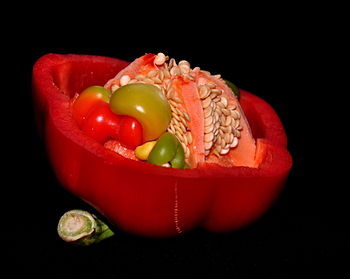
Selected biography –
B. 1618 – d. 1678
François Pierre de la Varenne (French pronunciation: [fʁɑ̃swa pjɛʁ də la vaʁɛn], 1615–1678 in Dijon), Burgundian by birth, was the author of Le Cuisinier françois (1651), one of the most influential cookbooks in early modern French cuisine. La Varenne broke with the traditions that had revolutionised medieval and Renaissance French cookery in the 16th century and early 17th century. ( Full article...)
Did you know (auto-generated) –

- ... that a British supermarket uses barriers to prevent shoppers grabbing food with yellow discount stickers out of the hands of staff?
- ... that in Spain, it is considered lucky to eat twelve grapes while wearing red underwear received as a gift at midnight on New Year's Eve?
- ... that some fans of Genshin Impact have referred to the character Paimon as "emergency food"?
- ... that exercises in the fair division of food are often used to teach unit fractions?
- ... that the vegan-food brand Squeaky Bean produces food that does not contain beans?
- ... that before Angeli Foods was sold this year, the first self-service grocery store in the Upper Peninsula of Michigan had been owned by three generations of a single family?
More did you know –
Related portals
Food topics
The following are topics relating to food
Categories
Food list articles
- See also: Lists of foods and Category:Lists of drinks
The following are some Food list articles on Wikipedia:

- American cheeses
- Appellation d'Origine Contrôlée cheeses
- Apple cultivars
- Bacon dishes
- Bacon substitutes
- Basil cultivars
- Breads
- Breakfast beverages
- Breakfast cereals
- Breakfast foods
- British cheeses
- Cakes
- Candies
- Cheeses
- Cheese soups
- Christmas dishes (list)
- Cocktails
- Cookies
- Dishes using coconut milk
- Diets
- Doughnut varieties
- Egg dishes
- Fermented soy products
- Food additives
- Food additives (Codex Alimentarius)
- Foods named after people
- French cheeses
- French dishes
- Fried dough foods
- Fruits
- List of hamburgers
- Herbs and spices
- Hors d'oeuvre
- Indian dishes
- Indian snack foods
- Indonesian dishes
- Italian dishes
- Japanese snacks
- Japanese dishes
- Jewish dishes
- Kebabs
- Korean beverages
- Mango cultivars
- Moroccan dishes
- Pasta
- Pastries
- Philippine snack food
- Pies, tarts and flans
- Poppy seed pastries and dishes
- Potato dishes
- Puddings
- Raw fish dishes
- Rice dishes
- Rolled foods
- Sauces
- Seafood
- Seeds
- Sandwiches
- Snack foods
- Soft drinks by country
- Soul foods and dishes
- Soups
- Stews
- Street foods
- Tapas
- Turkish dishes
- Twice-baked foods
- Vegetable oils
- Vegetables
- Vodkas
Things you can do
Related WikiProjects
| Parent project: WikiProject Food and Drink | |
| Child projects: | Task forces: (All inactive) |
|
|
| Related projects: | |
New articles
Rules | Match log | Results page (for watching) | Last updated: 2024-04-22 19:19 (UTC)
Note: The list display can now be customized by each user. See List display personalization for details.
- Rachel's Ginger Beer ( | talk | history | links | watch | logs | tools) by Another Believer ( talk · contribs · new pages (109)) started on 2024-04-22, score: 10
- Crisp pork ( | talk | history | links | watch | logs | tools) by チャリス ( talk · contribs · new pages (8)) started on 2024-04-22, score: 20
- "Flower" tofu ( | talk | history | links | watch | logs | tools) by チャリス ( talk · contribs · new pages (8)) started on 2024-04-22, score: 10
- Taro pastry ( | talk | history | links | watch | logs | tools) by Heeheemalu ( talk · contribs · new pages (16)) started on 2024-04-22, score: 10
- Garbage Plate ( | talk | history | links | watch | logs | tools) by BanjoZebra ( talk · contribs · new pages (8)) started on 2024-04-10, score: 40
- Morning in America (EP) ( | talk | history | links | watch | logs | tools) by OttoJohn ( talk · contribs · new pages (2)) started on 2024-04-21, score: 10
- Mike's Hot Honey ( | talk | history | links | watch | logs | tools) by BanjoZebra ( talk · contribs · new pages (8)) started on 2024-04-21, score: 40
- Zajiangmian ( | talk | history | links | watch | logs | tools) by チャリス ( talk · contribs · new pages (8)) started on 2024-04-21, score: 20
- Cannabis in the restaurant industry ( | talk | history | links | watch | logs | tools) by Another Believer ( talk · contribs · new pages (109)) started on 2024-04-21, score: 10
- Kentrell Barkley ( | talk | history | links | watch | logs | tools) by Skyggestadium ( talk · contribs · new pages (5)) started on 2024-04-21, score: 10
- Asarotos oikos ( | talk | history | links | watch | logs | tools) by Shakko ( talk · contribs · new pages (1)) started on 2024-04-09, score: 20
- Coffee Talk Episode 2: Hibiscus & Butterfly ( | talk | history | links | watch | logs | tools) by JuniperChill ( talk · contribs · new pages (8)) started on 2024-04-20, score: 20
- Dough Joy ( | talk | history | links | watch | logs | tools) by Another Believer ( talk · contribs · new pages (109)) started on 2024-04-20, score: 20
- Chicken galantina ( | talk | history | links | watch | logs | tools) by Obsidian Soul ( talk · contribs · new pages (16)) started on 2024-04-19, score: 20
- Ponche Navideño ( | talk | history | links | watch | logs | tools) by Valereee ( talk · contribs · new pages (10)) started on 2024-04-19, score: 20
- Lengua estofado ( | talk | history | links | watch | logs | tools) by Obsidian Soul ( talk · contribs · new pages (16)) started on 2024-04-19, score: 20
- PDX671 ( | talk | history | links | watch | logs | tools) by Another Believer ( talk · contribs · new pages (109)) started on 2024-04-19, score: 10
- Organic market in Ukraine ( | talk | history | links | watch | logs | tools) by QFTP2024 ( talk · contribs · new pages (1)) started on 2024-04-16, score: 10
- Taqua banana ( | talk | history | links | watch | logs | tools) by Fredo.fernando ( talk · contribs · new pages (1)) started on 2024-04-18, score: 10
- Butifarra (sandwich) ( | talk | history | links | watch | logs | tools) by Tony24644 ( talk · contribs · new pages (3)) started on 2024-04-18, score: 10
- Kuai Kuai ( | talk | history | links | watch | logs | tools) by Heeheemalu ( talk · contribs · new pages (16)) started on 2024-04-17, score: 20
- Rocklands Barbeque and Grilling Company ( | talk | history | links | watch | logs | tools) by DarkNight0917 ( talk · contribs · new pages (10)) started on 2024-04-17, score: 10
- Sweet Alchemy ( | talk | history | links | watch | logs | tools) by Another Believer ( talk · contribs · new pages (109)) started on 2024-04-16, score: 10
- Diet Coke ( | talk | history | links | watch | logs | tools) by 99.196.135.213 ( talk · contribs · new pages (1)) started on 2024-04-16, score: 20
- The Lakes Distillery ( | talk | history | links | watch | logs | tools) by ChefBear01 ( talk · contribs · new pages (4)) started on 2024-04-16, score: 20
- Cully & Sully ( | talk | history | links | watch | logs | tools) by Liz ( talk · contribs · new pages (83)) started on 2024-04-16, score: 30
- Trine Lotherington Danielsen ( | talk | history | links | watch | logs | tools) by Geschichte ( talk · contribs · new pages (39)) started on 2024-04-16, score: 10
- Medical Device User Fee and Modernization Act ( | talk | history | links | watch | logs | tools) by GobsPint ( talk · contribs · new pages (86)) started on 2024-04-16, score: 10
- Antioch Pizza ( | talk | history | links | watch | logs | tools) by Ms.Aloisia ( talk · contribs · new pages (1)) started on 2024-04-15, score: 10
- Guelaguetza (restaurant) ( | talk | history | links | watch | logs | tools) by Another Believer ( talk · contribs · new pages (109)) started on 2024-04-15, score: 10
- The Burque Bakehouse ( | talk | history | links | watch | logs | tools) by Another Believer ( talk · contribs · new pages (109)) started on 2024-04-12, score: 10
- Uneeda Biscuit ( | talk | history | links | watch | logs | tools) by CNMall41 ( talk · contribs · new pages (34)) started on 2024-04-10, score: 30
- Bersagh ( | talk | history | links | watch | logs | tools) by Hosseinblue ( talk · contribs · new pages (1)) started on 2024-04-15, score: 10
- Lucky Saint ( | talk | history | links | watch | logs | tools) by DanielMichaelPerry ( talk · contribs · new pages (2)) started on 2024-04-14, score: 20
- The Yeti Cafe ( | talk | history | links | watch | logs | tools) by PerfectSoundWhatever ( talk · contribs · new pages (4)) started on 2024-04-14, score: 10
- Fábrica Santo António ( | talk | history | links | watch | logs | tools) by AtlanteanAstorian ( talk · contribs · new pages (1)) started on 2024-04-13, score: 10
- Cocoa-free chocolate alternative ( | talk | history | links | watch | logs | tools) by Jesskarch ( talk · contribs · new pages (2)) started on 2024-04-12, score: 10
- Banana cream pie ( | talk | history | links | watch | logs | tools) by Valereee ( talk · contribs · new pages (10)) started on 2024-04-13, score: 30
- Menus-Plaisirs – Les Troisgros ( | talk | history | links | watch | logs | tools) by Cavarrone ( talk · contribs · new pages (56)) started on 2024-04-13, score: 20
- 2024 Andy's Frozen Custard 300 ( | talk | history | links | watch | logs | tools) by MysticCipher87 ( talk · contribs · new pages (3)) started on 2024-04-08, score: 10
- Gusto Bread ( | talk | history | links | watch | logs | tools) by Another Believer ( talk · contribs · new pages (109)) started on 2024-04-12, score: 10
- Korenya Shingetsuan ( | talk | history | links | watch | logs | tools) by Loukus999 ( talk · contribs · new pages (6)) started on 2024-04-12, score: 10
- 321 Coffee ( | talk | history | links | watch | logs | tools) by Sirdog ( talk · contribs · new pages (1)) started on 2024-04-12, score: 10
- Wei Lih Men ( | talk | history | links | watch | logs | tools) by Heeheemalu ( talk · contribs · new pages (16)) started on 2024-04-12, score: 20
- Pescado a la talla ( | talk | history | links | watch | logs | tools) by Opus88888 ( talk · contribs · new pages (1)) started on 2024-04-11, score: 20
- David S. Shellabarger ( | talk | history | links | watch | logs | tools) by Vanderwaalforces ( talk · contribs · new pages (150)) started on 2024-04-11, score: 10
- Pan minisc' ( | talk | history | links | watch | logs | tools) by Mariamnei ( talk · contribs · new pages (11)) started on 2024-04-11, score: 20
- Imperial Big Meal ( | talk | history | links | watch | logs | tools) by Heeheemalu ( talk · contribs · new pages (16)) started on 2024-04-11, score: 20
- Prince Noodles ( | talk | history | links | watch | logs | tools) by Heeheemalu ( talk · contribs · new pages (16)) started on 2024-04-11, score: 20
- TTL Hua Tiao Chicken Noodles ( | talk | history | links | watch | logs | tools) by Heeheemalu ( talk · contribs · new pages (16)) started on 2024-04-11, score: 20
- List of Michelin starred restaurants in Vietnam ( | talk | history | links | watch | logs | tools) by Crcolas ( talk · contribs · new pages (8)) started on 2024-04-10, score: 20
- Food journalism ( | talk | history | links | watch | logs | tools) by Sadads ( talk · contribs · new pages (16)) started on 2024-04-10, score: 10
- The Hangover (Suzanne Valadon) ( | talk | history | links | watch | logs | tools) by Viriditas ( talk · contribs · new pages (5)) started on 2024-04-10, score: 20
- Caidao ( | talk | history | links | watch | logs | tools) by Belarus101 ( talk · contribs · new pages (4)) started on 2024-04-10, score: 10
- Wobble to Death ( | talk | history | links | watch | logs | tools) by Lord Cornwallis ( talk · contribs · new pages (127)) started on 2024-04-09, score: 10
- Maple bacon donut ( | talk | history | links | watch | logs | tools) by Nikkimaria ( talk · contribs · new pages (2)) started on 2024-04-09, score: 40
- King (restaurant) ( | talk | history | links | watch | logs | tools) by MainlyTwelve ( talk · contribs · new pages (5)) started on 2024-04-08, score: 10
- Shanzhagao ( | talk | history | links | watch | logs | tools) by Jeromeenriquez ( talk · contribs · new pages (10)) started on 2024-04-08, score: 10
Associated Wikimedia
The following Wikimedia Foundation sister projects provide more on this subject:
-
Commons
Free media repository -
Wikibooks
Free textbooks and manuals -
Wikidata
Free knowledge base -
Wikinews
Free-content news -
Wikiquote
Collection of quotations -
Wikisource
Free-content library -
Wikiversity
Free learning tools -
Wiktionary
Dictionary and thesaurus





















